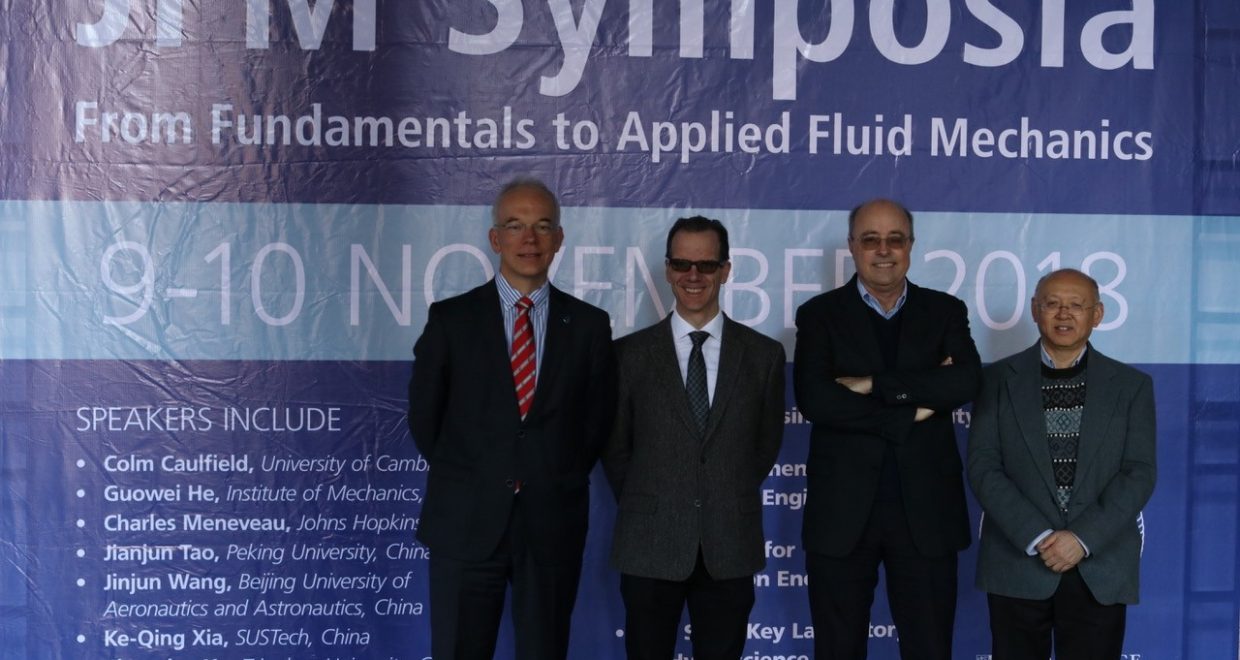JFM Symposia China: Beijing
The third and final event of the JFM China Symposia was held at Tsinghua University in Beijing with a record attendance of over 300 delegates representing the full-scope of academic profiles, from professors to undergraduate students. The four JFM editors present were also clearly very excited for the event, as they insisted on posing for a group photograph before the talks could get underway!

Dean of the Graduate School, Qiang Yao, opened proceedings with a welcome speech, before Kathleen Too, Publisher for the Physical Sciences at CUP, presented him with a gift on behalf of Cambridge University Press. Kathleen then gave a short talk on the history of CUP from its foundation to the present day , stating that young researchers are the future of fluid mechanics and how we look forward to increased engagement with the journal, whether as an author, reader, or referee.
Colm Caulfield of DAMTP at the University of Cambridge, began the scientific schedule with his talk on ‘adjoint-based methods for flow stability, control and mixing’. Professor Caulfield’s entertaining talk focussed on identifying the cause of the onset of turbulence, as he cited the expression ‘prevention is better than cure’. He also referenced the classical problem of the shape of a hanging chain as he discussed the Lagange multiplier method used in the work.
Next it was the turn of the local speakers with Guowei He of CAS, Ke-Qing Xia of the Southern University of Science and Technology and Jianjun Tao of Peking University taking to the stage. Professor He gave a very nice summary of the history of turbulence research from Kolmogorov in 1941 to the work of his group in the present day, whilst Professor Tao described a new state of ‘sparse turbulence’ identified by his research. Professor Xia’s explanation of the global ocean circulation and its 1000-year timescale was another highlight.
The afternoon session saw a further four academic talks beginning with JFM Deputy Editor Charles Meneveau of Johns Hopkins University taking us through the modelling of wind turbines, from turbulent boundary layers to spatial and temporal power distributions. His description of wind energy as a “variable, intermittent and hard to predict resource, which needs to be better understood if we are to use it properly” seems particularly apt given the current need for a transition to renewable energy resources.
We next welcomed our first female speakers of the day with Chunxiao Xu of Tsinghua University presenting her research on near-wall turbulence, before the President of Xidian University, Xiaojing Zheng, discussed her incredibly thorough work on sand and dust storms. The project used data collected over four years of field measurements, laboratory wind tunnel tests and numerical simulations, only being completed two weeks. I imagine one could refer to it as hot off the (Cambridge University) Press…
The final scientific talk of the day was given by Chong Pan of Beihang University who heroically stepped in to present the work of Jinjun Wang who unfortunately could not present his workdue to recent dental surgery. Professor Chong explained how bubbles and drops in turbulent regions are in fact manifestations of areas of low and high vorticity respectively.
As with the previous symposia, the day concluded with a panel discussion with JFM editors answering questions from the audience. A wide range of topics were covered including papers consisting of several parts, topics of interest to the journal and the direction of the field in China, but the highlight was undoubtedly hearing each editor reminisce about the first paper they published in the journal earlier in their careers.
Finally, it just leaves me to say congratulations to the poster winners Pengyu Lv at Peking University and Xin Chen of Northwestern Polytechnical University, and a huge thank you to our hosts at Tsinghua University and the attendees for helping to make the final symposia in China the biggest and most successful yet!






